The Intel Core i3-7350K (60W) Review: Almost a Core i7-2600K
by Ian Cutress on February 3, 2017 8:00 AM ESTLegacy and Synthetic Tests
At AnandTech, I’ve taken somewhat of a dim view to pure synthetic tests, as they fail to be relatable. Nonetheless, our benchmark database spans to a time when that is all we had! We take a few of these tests for a pin with the latest hardware.
Cinebench R10
The R10 version of Cinebench is one of our oldest benchmarks, with data going back more than a few generations. The benchmark is similar to that of the newest R15 version, albeit with a simpler render target and a different strategy for multithreading.
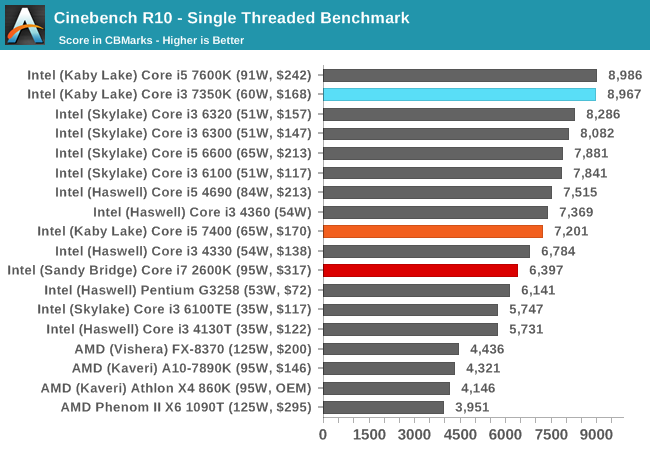
With high frequency in tow, the Core i3-7350K makes its mark.
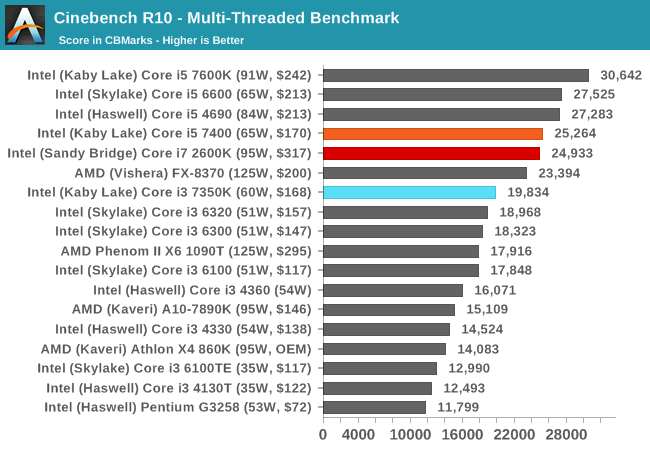
When more threads come to play, the Core i5-7400 and Core i7-2600K battle it out in terms of four cores and IPC vs hyperthreading. The Core i3-7350K sits around ~25% behind.
Cinebench R11.5
CB11.5 has been popular for many years as a performance test, using easy to read and compare numbers that aren’t in the 1000s. We run the benchmark in an automated fashion three times in single-thread and multi-thread mode and take the average of the results.
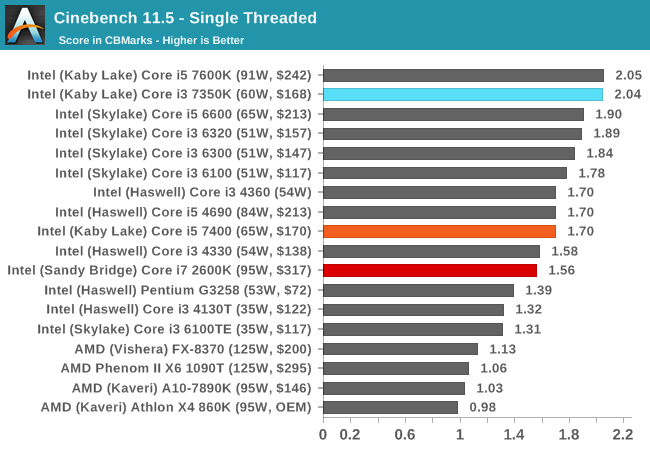
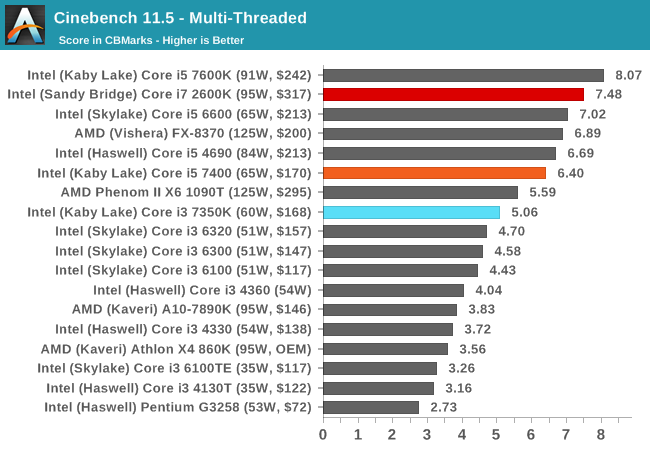
Similar to CB10, the single thread results show that a 4.2 GHz Kaby Lake is nothing to be sniffed at. In the multithreaded test, CB11.5 is more able to leverage the hyperthreads, showing that a Core i7-2600K will run rings around the low end Kaby i5, but is bested by the higher frequency Kaby i5-K. The Core i3 still has that dual core deficit.
7-zip
As an open source compression/decompression tool, 7-zip is easy to test and features a built-in benchmark to measure performance. As a utility, similar to WinRAR, high thread counts, frequency and UPC typically win the day here.
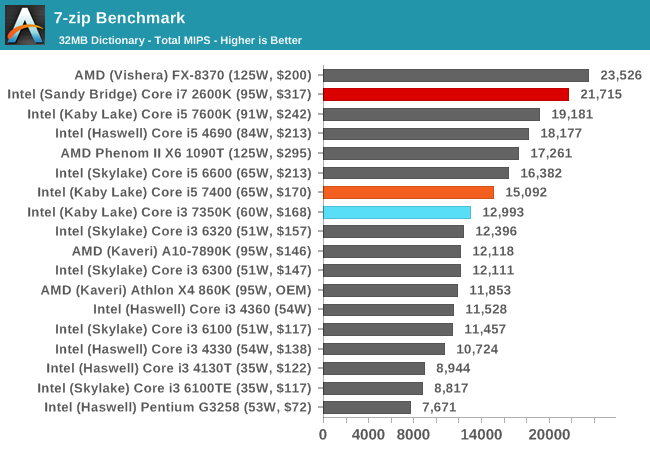
The difference between the i3-7350K and the i5-7400 shows that 7-zip prefers cores over threads, but the Core i7-2600K results show it can use both to good effect, even on older microarchitectures, scoring almost double the i3-7350K.
POV-Ray
Ray-tracing is a typical multithreaded test, with each ray being a potential thread in its own right ensuring that a workload can scale in complexity easily. This lends itself to cores, frequency and IPC: the more, the better.

POV-Ray is a benchmark that is usually touted as liking high IPC, high frequency and more threads. The i7-2600K, despite having double the resources of the Core i3-7350K, is only 30% ahead.
AES via TrueCrypt
Despite TrueCrypt no longer being maintained, the final version incorporates a good test to measure different encryption methodologies as well as encryption combinations. When TrueCrypt was in full swing, the introduction of AES accelerated hardware dialed the performance up a notch, however most of the processors (save the Pentiums/Celerons) now support this and get good speed. The built-in TrueCrypt test does a mass encryption on in-memory data, giving results in GB/s.
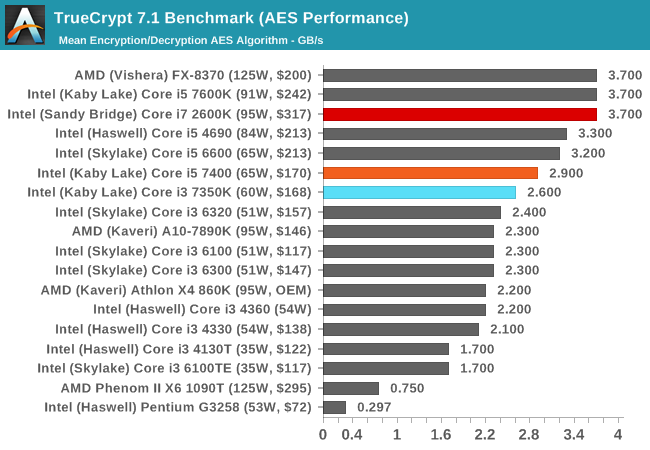










186 Comments
View All Comments
Flunk - Monday, February 6, 2017 - link
Yeah, that is funny. I'm using a massively overpowered PSU myself. I have a 850W unit running a system with a moderately-overclocked i7-6700k and Geforce 1070. Had it left over from my previous massively overclocked i5-2500k and dual Radeon 7970s, even if it's aged badly (which it probably hasn't it's only a few years old) it should still be good for ages, especially as under-stressed as it now is.fanofanand - Friday, February 3, 2017 - link
Or you could just get Ryzen with the wraith cooler :)BrokenCrayons - Friday, February 3, 2017 - link
Perhaps when they're available for purchase I'll look into it. I'm interested in seeing what AMD does with mobile Ryzen, integrated graphics, and HBM for CPUs (unlikely) and how it changes laptop computing.fanofanand - Friday, February 3, 2017 - link
The rumor mill has been churning and the consensus is that APU's will be available in 2018 with HBM. That will be a game changer for more than just mobile computing, but for small form factors as well. At least theoretically, experience tells me we should wait for reviews before deciding how profound the impact will be.Flunk - Monday, February 6, 2017 - link
The Wraith cooler is both marginal and loud compared to quality aftermarket coolers that cost as little as $35. Sure it's better than the last AMD stock cooler, but that's more a case of the last AMD stock cooler being total garbage.bananaforscale - Wednesday, February 8, 2017 - link
Hey, no dissing huge air coolers! :D (Yeah, I have one and it's so big it largely dictated the case selection. Does keep a hexcore Bulldozer at 52 degrees at 4 GHz tho.) There's also the niggle on Intel side that their enthusiast line has only made it to Broadwell-E, so that's what I'll be upgrading to. A huge upgrade in IPC (which probably won't rise much in the next years), more cores and lower power use per core. I figure I'll be upgrading next around 2025. :D I'm pondering whether I should go AIO liquid or custom...MonkeyPaw - Friday, February 3, 2017 - link
More emphasis is going into the IGP.CaedenV - Friday, February 3, 2017 - link
I doubt it is competition. I mean, lack of competition certainly explains the price per performance not coming down even though the manufacturing costs are getting cheaper, but I think that we have hit a performance wall.With every die shrink we can get more performance per watt... but the die is also more heat sensitive which kills stability for higher clocks. The idea that you can hit 5GHz on the new chips is nothing short of a miracle! But without a major increase in clock speed, then your performance is limited to the instruction sets and execution model... and that is much harder to change.
And that isn't hard to change because of competition. That is hard to change because PCs live and die by legacy applications. If I can't go back and play my 20 year old games every 3-4 years then I am going to get rather annoyed and not upgrade. If businesses can't run their 20 year old software every day, then they will get annoyed and not upgrade.
I think we are rather stuck with today's performance until we can get a new CPU architecture on the market that is as good as ARM on the minimum power consumption side, but as efficient as x86 on the performance per watt side... but whatever chip comes out will have to be able to emulate today's x86 technology fast enough to feel like it isn't a huge step backwards... and that is going to be hard to do!
xenol - Friday, February 3, 2017 - link
Anandtech please do frame-time tests as well for games. Average frame rate is good and all, but if the processor causes dips in games that could lead to an unpleasant experience.Mr Perfect - Friday, February 3, 2017 - link
I would also be interested in seeing this.The site slips my mind, but somewhere tested multiple generations of i7s, i5s and i3s for minimum framerate and even the oldest i7s had a more consistent framerate then the newest i3s. It would be interesting to get AT's take on this.